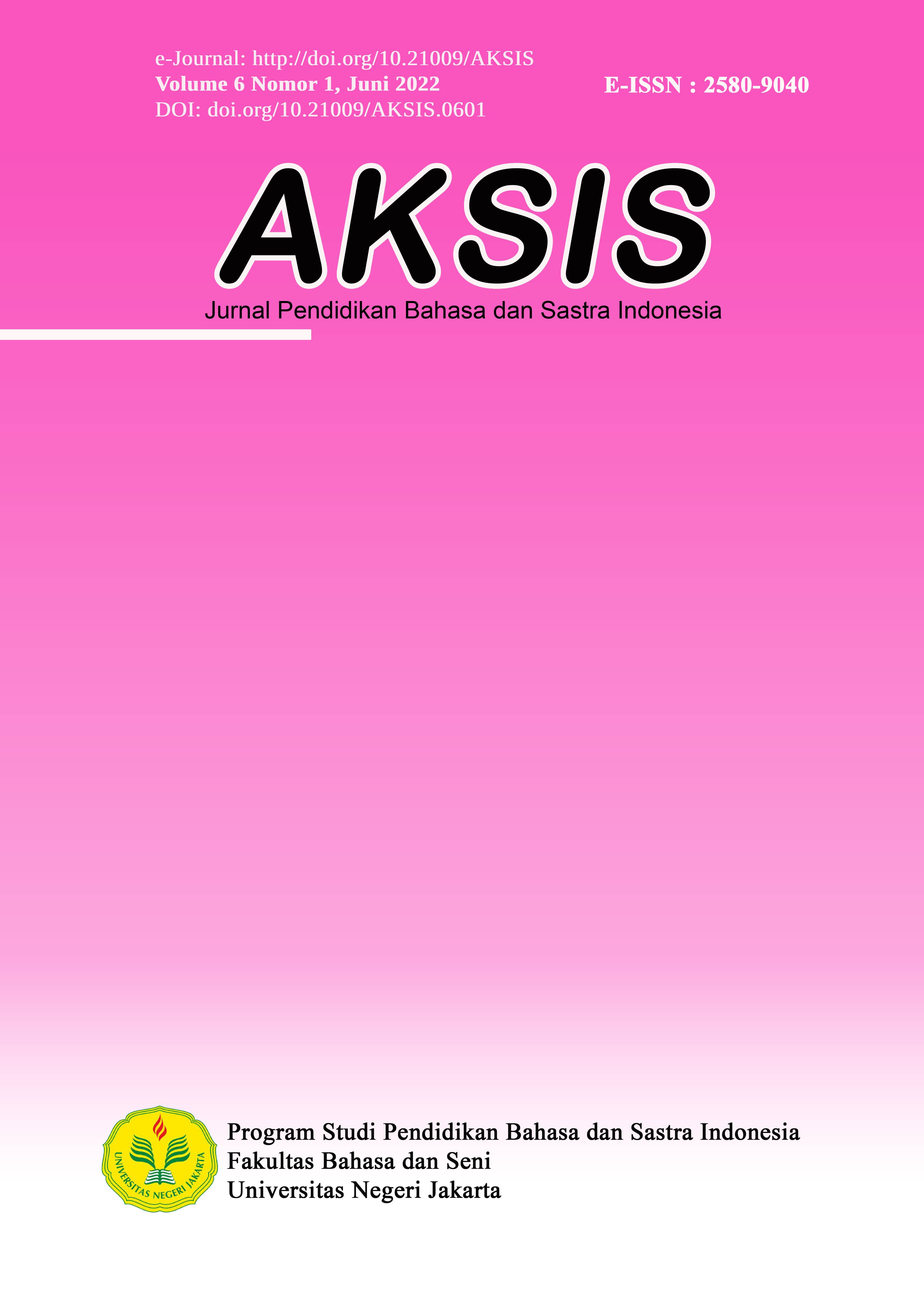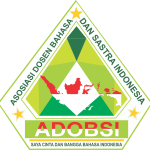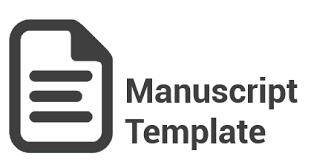Analysis of Negotiation Text Writing Ability in Class X Students of SMA Nurul Iman Tanjung Morawa in the 2020/2021 Academic Year
DOI:
https://doi.org/10.21009/AKSIS.060107Keywords:
writing skills, negotiation textAbstract
This study aims to describe the ability to write negotiating texts for tenth grade students of SMA Nurul Iman Tanjung Morawa. The population of this study was all students of class X SMA Nurul Iman Tanjung Morawa in the 2020/2021 academic year. The population of this study was all students of class X SMA Nurul Iman Tanjung Morawa in the 2020/2021 academic year which consisted of 10 classes with a total of 132 students. For this study, the sample taken was class X MIA-1, totaling 29 students through random sampling technique. This research uses descriptive analysis method. The data collection technique in this research is documentation. The research instrument used was a negotiating text writing test. The results showed that the ability of class X students of SMA Nurul Iman Tanjung Morawa in writing negotiating texts based on the structural aspect got an average score (93) in the very good category and the linguistic feature aspect got an average score (78.15) in the good category. . Based on the distribution table of the percentage value of the ability to write negotiating texts for class X students of SMA Nurul Iman Tanjung Morawa in; (1) the structural aspect shows the very good category (79.31%), good category (20.69%), quite good category (0%), and poor category (0%). (2) the aspect of linguistic characteristics shows in the very good category (31.04%), good category (51.72%), quite good category (17.24%), and poor category (0%). (3) the aspect of structure and linguistic characteristics shows in the very good category (34.48%), good category (58.62%), quite good category (6.89%), and poor category (0%). Indonesian language teachers can determine students' writing abilities, especially in writing negotiating texts based on structural aspects and aspects of linguistic characteristics. After knowing the students' abilities, the teacher can further improve the effectiveness of learning to write negotiating texts.
References
Batchelor, S., Gilmore, C., & Inglis, M. (2017). Parents’ and Children’s Mathematics Anxiety. In Understanding Emotions in Mathematical Thinking and Learning (pp. 315-336). Elsevier Inc. https://psycnet.apa.org/record/2017-28637-012
Birgin, O., Baloǧlu, M., Çatlioǧlu Hakan, H., & Gürbüz Ramazan, R. (2010). An investigation of mathematics anxiety among sixth through eighth grade students in Turkey. Learning and Individual Differences, XX(6), 654–658.https://www.sciencedirect.com/science/article/abs/pii/S1041608010000415
Bressoud, D. M. (2015). Insights from the MAA National Study of College Calculus. The Mathematics Teacher, CIX(3), 178–185.
Bressoud, D. M. (2020). Opportunities for Change in the First Two Years of College Mathematics. Bulletin of Mathematical Biology, LXXXII(5), 1–12. https://link.springer.com/article/10.1007/s11538-020-00738-7
Bressoud, D. M., Carlson, M. P., Mesa, V., & Rasmussen, C. (2013). The calculus student: insights from the Mathematical Association of America national study. International Journal of Mathematical Education in Science and Technology, XLIV(5), 685–698.https://www.tandfonline.com/doi/abs/10.1080/0020739X.2013.798874
Carey, E., Hill, F., Devine, A., & Szucs, D. (2017). The modified abbreviated math anxiety scale: A valid and reliable instrument for use with children. Frontiers in Psychology, VIII(JAN), 1–13. https://www.frontiersin.org/articles/10.3389/fpsyg.2017.00011/full
Cargnelutti, E., Tomasetto, C., & Passolunghi, M. C. (2017). How is anxiety related to math performance in young students? A longitudinal study of Grade 2 to Grade 3 children. Cognition and Emotion, XXXI(4), 755–764. DOI: 10.1080/02699931.2016.1147421
Çatlioǧlu, H., Birgin, O., Coştu, S., & Gürbüz, R. (2009). The level of mathematics anxiety among pre-service elementary school teachers. Procedia - Social and Behavioral Sciences, I(1), 1578–1581. https://www.sciencedirect.com/science/article/pii/S1877042809002808
Cohen, J. E. (2004). Mathematics is biology’s next microscope, only better; biology is mathematics’ next physics, only better. PLoS Biology, II(12). https://journals.plos.org/plosbiology/article?id=10.1371/journal.pbio.0020439
Creswell, J. (2012). Educational Research: Planning, Conducting, and Evaluating. Quantitative and Qualitative Research, 4nd edition (4th ed.). Pearson. Retrieved from https://ejournal.poltektegal.ac.id/index.php/siklus/article/view/298%0Ahttp://repositorio.unan.edu.ni/2986/1/5624.pdf%0Ahttp://dx.doi.org/10.1016/j.jana.2015.10.005%0Ahttp://www.biomedcentral.com/1471-2458/12/58%0Ahttp://ovidsp.ovid.com/ovidweb.cgi?T=JS&P
Eaton, C. D., & Highlander, H. C. (2017). The case for biocalculus: Design, retention, and student performance. CBE Life Sciences Education, XVI(2), 1–22. https://www.lifescied.org/doi/full/10.1187/cbe.15-04-0096
Eaton, C. D., LaMar, M. D., & McCarthy, M. L. (2020). 21st Century Reform Efforts in Undergraduate Quantitative Biology Education. Letters in Biomathematics,VII(1), 55–66. Retrieved from https://lettersinbiomath.journals.publicknowledgeproject.org/index.php/lib/article/view/215
Gross, L. J. (2004). Interdisciplinarity and the Undergraduate Biology Curriculum: Finding a Balance. Cell Biology Education, III(2), 88–90. https://www.ncbi.nlm.nih.gov/pmc/articles/PMC437648/
Gao, X., Li, P., Shen, J., & Sun, H. (2020). Reviewing assessment of student learning in interdisciplinary STEM education. International Journal of STEM Education, VII(24), 1-14. https://stemeducationjournal.springeropen.com/articles/10.1186/s40594-020-00225-4
Hester, S., Buxner, S., Elfring, L., & Nagy, L. (2014). Integrating quantitative thinking into an introductory biology course improves students’ mathematical reasoning in biological contexts. CBE Life Sciences Education, XIII(1), 54–64. https://www.lifescied.org/doi/10.1187/cbe.13-07-0129
Hopko, D. R. (2003). Confirmatory factor analysis of the math anxiety rating scale-revised. Educational and Psychological Measurement, LXIII(2), 336–351. doi: 10.1177/0013164402251041
Hopko, D. R., Mahadevan, R., Bare, R. L., & Hunt, M. K. (2003). The Abbreviated Math Anxiety Scale (AMAS): Construction, validity, and reliability. Assessment, X(2), 178–182. https://journals.sagepub.com/doi/10.1177/1073191103010002008
Hoskinson, A.-M. (2010). How to Build a Course in Mathematical–Biological Modeling: Content and Processes for Knowledge and Skill. CBE—Life Sciences Education, IX(1), 333–341. https://pubmed.ncbi.nlm.nih.gov/20810966/
Jungck, J. R., Robeva, R., & Gross, L. J. (2020). Mathematical Biology Education: Changes, Communities, Connections, and Challenges. Bulletin of Mathematical Biology, LXXXII(9), 1–14. https://link.springer.com/article/10.1007/s11538-020-00793-0
Matthews, K. E., Adams, P., & Goos, M. (2009). Putting it into perspective: Mathematics in the undergraduate science curriculum. International Journal of Mathematical Education in Science and Technology, XL(7), 891–902.https://www.tandfonline.com/doi/abs/10.1080/00207390903199244
Matthews, K. E., Adams, P., & Goos, M. (2010). Using the principles of BIO2010 to develop an introductory, interdisciplinary course for biology students. CBE Life Sciences Education, IX(3), 290–297. https://www.lifescied.org/doi/full/10.1187/cbe.10-03-0034
Matthews, K. E., Hodgson, Y., & Varsavsky, C. (2013). Factors influencing students’ perceptions of their quantitative skills. International Journal of Mathematical Education in Science and Technology, XLIV(6), 782–795. https://www.tandfonline.com/doi/abs/10.1080/0020739X.2013.814814
Mayes, R., Long, T., Huffling, L., Reedy, A., & Williamson, B. (2020). Undergraduate Quantitative Biology Impact on Biology Preservice Teachers. Bulletin of Mathematical Biology, LXXXII(6). https://www.researcher-app.com/paper/5022361
McGinnis, J. R., Kramer, S., Shama, G., Graeber, A. O., Parker, C. A., & Watanabe, T. (2002). Undergraduates’ Attitudes and Beliefs about Subject Matter and Pedagogy Measured Periodically in a Reform-Based Mathematics and Science Teacher Preparation Program. Journal of Research in Science Teaching, XXXIX(8), 713–737. https://onlinelibrary.wiley.com/doi/10.1002/tea.10042
Milovanović, I., & Branovački, B. (2020). Adaptation and Psychometric Evaluation of Modified Abbreviated Math Anxiety Scale for Children in Serbia. International Journal of Science and Mathematics Education. https://link.springer.com/article/10.1007/s10763-020-10066-w
NRC. (2003). BIO2010: Transforming Undergraduate Education for Future Research Biologists. In National Academies Press. National Academies Press.
NRC. (2009). A NEW BIOLOGY FOR THE 21 ST CENTURY Statement of. National Academies Press.
Núñez-Peña, M. I., Suárez-Pellicioni, M., Guilera, G., & Mercadé-Carranza, C. (2013). A Spanish version of the short Mathematics Anxiety Rating Scale (sMARS). Learning and Individual Differences, 24, 204–210. https://www.sciencedirect.com/science/article/abs/pii/S1041608012001902
Poladian, L. (2013). Engaging life-sciences students with mathematical models: Does authenticity help? International Journal of Mathematical Education in Science and Technology, XLIV(6), 865–876. https://www.tandfonline.com/doi/abs/10.1080/0020739X.2013.811301
Prahmana, R. C. I., Sutanti, T., Wibawa, A. P., & Diponegoro, A. M. (2019). Mathematical Anxiety Among Engineering Students. Infinity Journal, VIII(2), 179.http://e-journal.stkipsiliwangi.ac.id/index.php/infinity/article/view/1385
Primi, C., Busdraghi, C., Tomasetto, C., Morsanyi, K., & Chiesi, F. (2014). Measuring math anxiety in Italian college and high school students: Validity, reliability and gender invariance of the Abbreviated Math Anxiety Scale (AMAS). Learning and Individual Differences, XXXIV, 51–56. https://www.sciencedirect.com/science/article/abs/pii/S1041608014001058
Ramirez, G., Hooper, S. Y., Kersting, N. B., Ferguson, R., & Yeager, D. (2018). Teacher Math Anxiety Relates to Adolescent Students’ Math Achievement. AERA Open, IV(1), 233285841875605. https://journals.sagepub.com/doi/full/10.1177/2332858418756052
Rawa, N. R., & Mastika Yasa, P. A. E. (2019). Kecemasan Matematika Pada Mahasiswa Pendidikan Guru Sekolah Dasar. Journal of Education Technology, II(2), 36. https://ejournal.undiksha.ac.id/index.php/JET/article/view/16180
Richardson, F. C., & Suinn, R. M. (1972). The Mathematics Anxiety Rating Scale: Psychometric data. Journal of Counseling Psychology, XIX(6), 551–554. https://psycnet.apa.org/record/1973-05788-001
Rizta, A., & Antari, L. (2018). Tingkat Mathematics Anxiety Pada Mahasiswa Calon Guru Matematika. Jurnal Pendidikan Matematika, XIII(1), 9–20.https://ejournal.unsri.ac.id/index.php/jpm/article/view/6827/pdf
Shen, J., Liu, O. L., & Shannon, S. (2014). Designing Interdisciplinary Assessments in Sciences for College Students: An example on osmosis. International Journal of Science Education, XXXVI(11), 1773-1793. https://www.tandfonline.com/doi/abs/10.1080/09500693.2013.879224
Suratmi, S., Abdullah, R., & Taufik, M. (2017). Hubungan Antara Tingkat Kecemasan dengan Hasil Belajar Mahasiswa di Program Studi Pendidikan Biologi UNTIRTA. Jurnal Pembelajaran Biologi: Kajian Biologi dan Pembelajarannya, IV(1), 71-76. https://ejournal.unsri.ac.id/index.php/fpb/article/view/4952
Taylor, R. T., Bishop, P. R., Lenhart, S., Gross, L. J., & Sturner, K. (2020, March 1). Development of the BioCalculus Assessment (BCA). CBE—Life Sciences Education, XIX(1), 1-12. https://www.lifescied.org/doi/abs/10.1187/cbe.18-10-0216
Thompson, K. V., Cooke, T. J., Fagan, W. F., Gulick, D., Levy, D., Nelson, K. C., Redish, E. F., Smith, R. F., & Presson, J. (2013). Infusing quantitative approaches throughout the biological sciences curriculum. International Journal of Mathematical Education in Science and Technology, XLIV(6), 817–833. https://www.tandfonline.com/doi/abs/10.1080/0020739X.2013.812754
Vahedi, S., & Farrokhi, F. (2011). A confirmatory factor analysis of the structure of abbreviated math anxiety scale. Iranian Journal of Psychiatry, VI(2), 47–53.
Wachsmuth, L. P., Runyon, C. R., Drake, J. M., & Dolan, E. L. (2017). Do biology students really hate math? Empirical insights into undergraduate life science majors’ emotions about mathematics. CBE Life Sciences Education, XVI(3), 1–10. https://www.lifescied.org/doi/full/10.1187/cbe.16-08-0248






